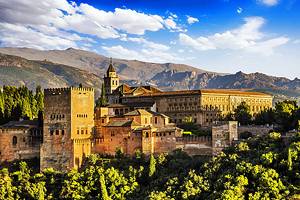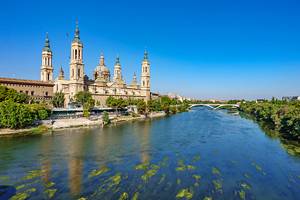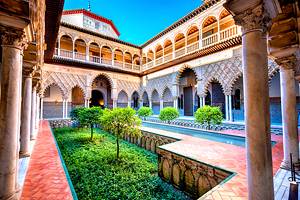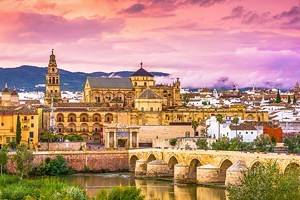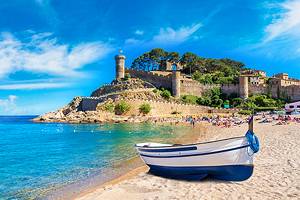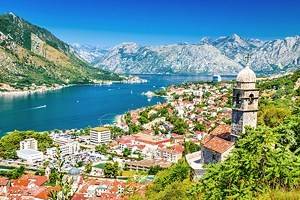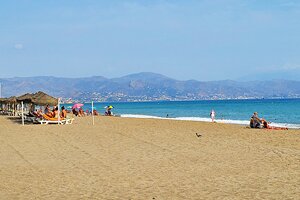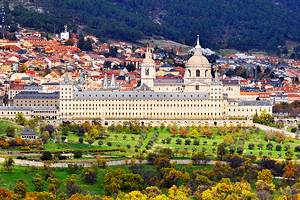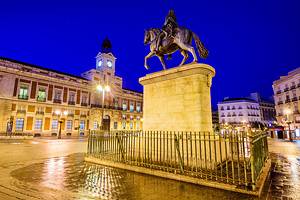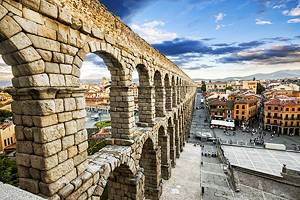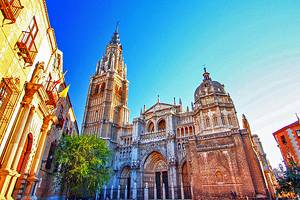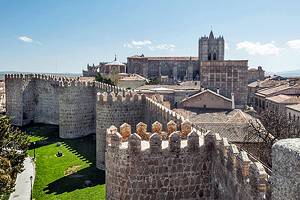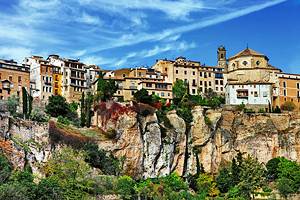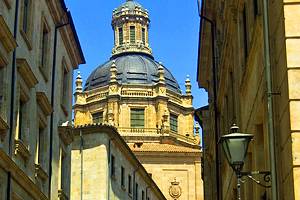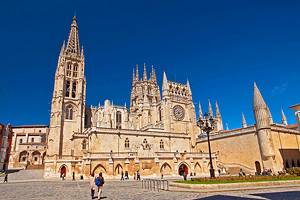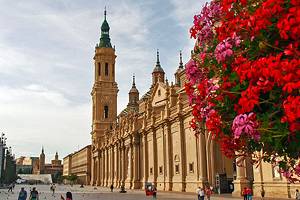Castles in Spain
Spain is home to some of the world's most iconic fairy-tale castles and medieval fortresses, including the palace that inspired Walt Disney's vision of Cinderella's castle. Most of Spain's castles were built to serve as both royal residences and military fortifications, resulting in palaces that are both beautiful and imposing.
Architectural styles vary significantly depending on region and era, but some of the most stunning palaces include the ornate flourishes of Moorish design, with the most impressive examples found at Granada's Alhambra.
Many of these castles have a combination of styles that reflect the changes and additions made after conquering rulers took over, including the addition of churches to former Islamic fortresses.
For inspiration, check out our list of the best castles in Spain.
Alcázar de Segovia
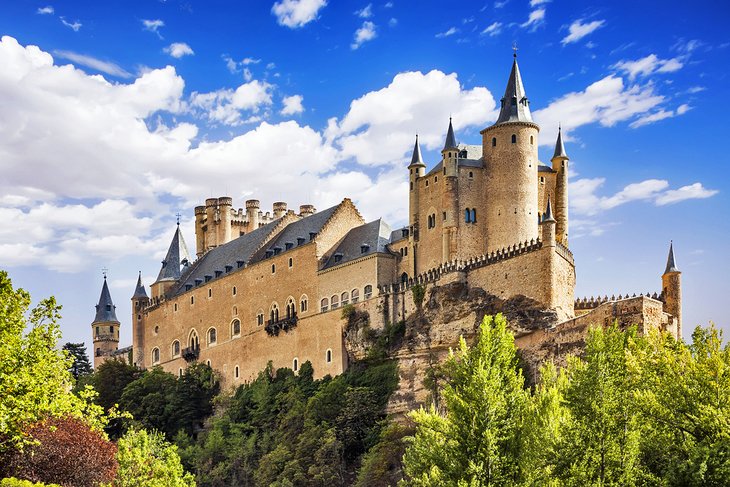
Perched on the rocky slopes of a hill that overlooks Segovia, the Alcázar was built to serve as both a fortress and royal residence. It is most widely known as the castle that inspired the design of Cinderella's Castle at Walt Disney World. Architectural elements, like its numerous conical roofs and turreted towers, have become the model for the perfect fairy-tale castle.
The castle was first constructed during the 12th century, built as the residence of King Alfonso III. It was modified and expanded over the centuries by subsequent rulers, including Isabela I who was crowned here in 1474.
Among the castle's most notable features is the Torre de Juan (Tower of John II), which is the tallest section of the fortress. This rectangular tower is decorated with a dozen ornamental turrets, and those who are willing to climb its 156 steps can enjoy stunning panoramic views from its roof.
Another ideal place to visit for excellent views is the Sala de Galera, featuring tall windows that overlook the valley below. The throne room, known as the Sala de los Reyes, has an astounding number of gilded features including a stunning ceiling and a frieze that depicts the 52 kings who ruled here.
Visitors can access all areas of the castle, and an audio guide is available. Chambers and halls are fully furnished in the height of medieval style, featuring original and reproduction tapestries, as well as armor and weaponry once used by the king's army.
- Read More: Tourist Attractions in Segovia
The Alhambra, Granada
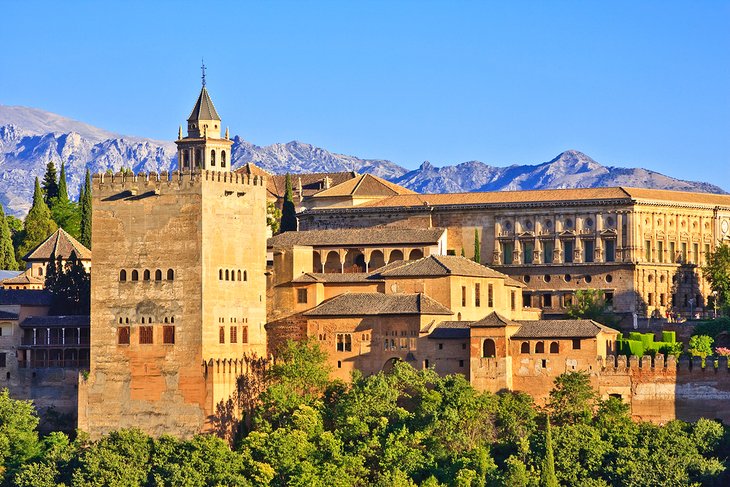
The massive Alhambra complex, which stands guard over Granada is the city's crowning jewel. Formerly the site of a Roman fortress and later a ninth-century fortification, the Alhambra as we see it today was begun in earnest during the thirteenth century by Moorish Nasrid Sultans.
Despite its eventual fall to Ferdinand and Isabella in the late 15th century, much of the palace has retained the lavish decorative embellishments of Moorish styles, and it is considered one of the best examples in the world.
Just past the entrance to the complex but outside the main walls sits the Generalife area, which once served as the recreational area for the sultans in residence. Along with the beautiful buildings, there are the expansive Jardines Bajos (Lower Gardens), as well as the Escalera de Agua, a beautiful feat of engineering that provided irrigation.
More gardens meet visitors as you make your way toward the heart of the citadel, home of the Palacios Nazaries (Nasrid Palaces) and the Palacio de Carlos V, a massive square structure with a colonnaded circular courtyard at its center. This building now houses the Museo de Alhambra and the Museo de Bellas Artes (Fine Arts Museum), as well as various temporary exhibits.

The three Palacios Nazaries include the Palacio de Comares (Palace of Ceremonial Rooms), Palacio de los Leones (Palace of the Lions), and the Palacio Real (Royal Palace). Each has a similar layout in the Andalusian style, with all of the main rooms opening up onto a central courtyard. The most well-known courtyard is the Patio de los Leones, home to a fountain made of a dozen marble lions surrounded by 124 arcaded columns.
Each section has numerous highlights, but one of the most impressive elements is the intricate carving and ornamentation that seems to cover every inch of the palaces.
In addition to a seemingly endless number of rooms, patios, and fountains, multiple towers keep watch over the citadel. The largest of these is the Torre de Comares, home of the Sala de los Embajadores. This room is arguably one of the most stunning you will find anywhere in Europe, flanked with tall windows and capped with an intricately carved wooden dome.
Those interested in the military sections of the citadel can also visit the smaller Alcazaba section, located at the far end of the complex. It sits just beyond the massive gates of the Puerta del Vino, once the main entrance.
Tourists should purchase their tickets well in advance to ensure entry, and plan to arrive early in order to enjoy as much of the historic site as possible.
- Read More: Visiting the Alhambra: Attractions
Castillo de Coca (Coca Castle)
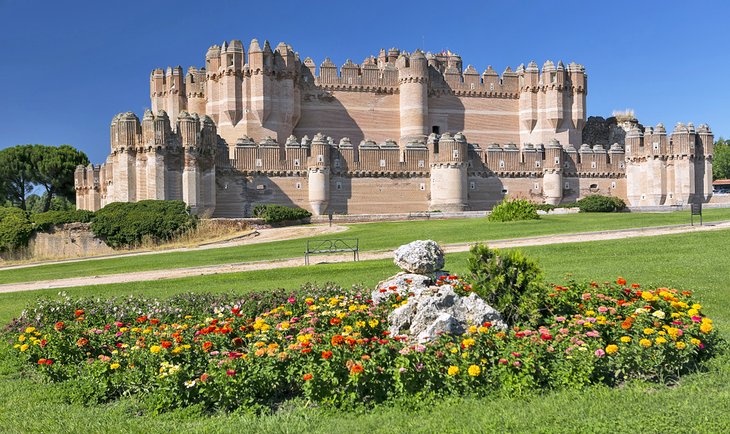
Located in the town of Coca in the Segovia region, Coca Castle is a stunning Christian-era palace featuring a tan brick exterior and multiple towers. Although it was built in the 15th century, the castle's architecture reflects the ongoing popularity of the Aracbic Mudejar style.
Unfortunately, the interior of the castle is in poor condition, however guided tours provide insight into what the palace looked like in its heyday as the seat of the Crown of Castille.
The castle's numerous crenelated battlements with their pointed Moorish merlons are more decorative than functional, as this was built to be a showy residence and not a military fortification. This is even more evident in the castle's location on a low escarpment, with a 40-foot-deep moat as its primary protection form unauthorized entrance. Today, the moat sits dry, circling the castle in a pattern that reflects the outline of large circular towers positioned at each corner.
Castillo de Loarre (Loarre Castle)
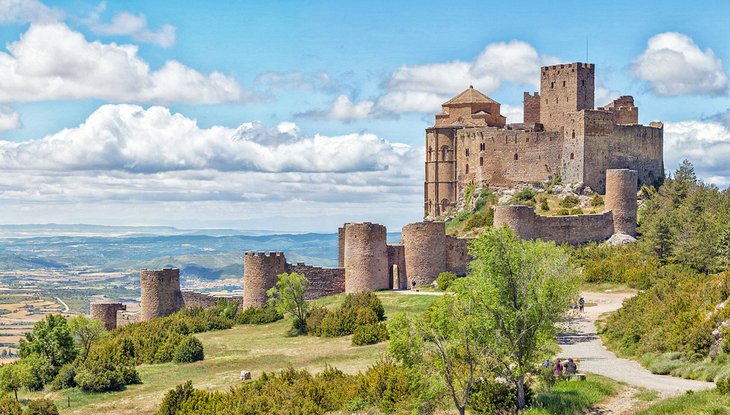
Located in northeastern Spain about two hours from Pamplona, Loarre Castle sits perched on a hill overlooking the Pyrenees mountain village of Ayerbe. It is distinctive for its series of cylindrical towers that seem to lead up the hill to the castle proper, the remains of defensive posts that once stood guard along the partially ruined outer wall. These, as well as the fortress's main towers, have crenelated parapets with rectangular merlon, reminiscent of storybook medieval castles.
Designed as both a military fortification and a royal residence, this castle is particularly well-protected by the limestone bedrock that forms its foundation, barring sneak attacks from an underground tunnel. It was built in the late 11th century for King Sancho Ramírez I of Aragon, and in the following century the Romanesque Church of Santa María was added. Later, the castle would house an Augustinian monastery.
This is one of Spain's few castles that does not have any Moorish influences in its architecture.
Olite Castle (Royal Palace of Olite)
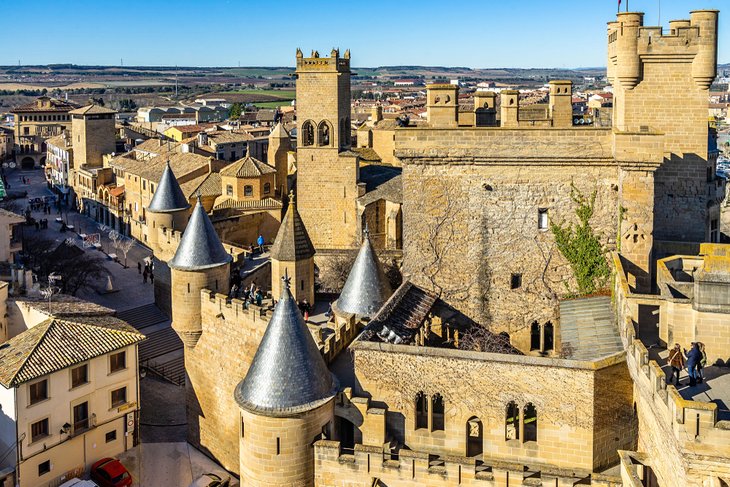
The Royal Palace of Olite was built during the 12th and 13th centuries on the site of a former Roman fortress. The original section is known now as the Palacio Vieja (Old Palace), and the Palacio Nueuvo (New Palace) was added in the 15th century. Overall, it is an example of predominantly Gothic architecture.
The palace was known for its lavish decoration and over-the-top features that were the whim and fancy of the Kings of Navarre. Among the marvels that once filled the palace were expansive hanging gardens, areas that displayed exotic animals, and an interior arena that hosted jousting matches and bullfights.
This is a particularly photogenic castle thanks to its brick-and-stone exterior and irregular layout. Capped towers, parapets, and keeps seem to have been haphazardly placed, but the asymmetry just adds to the charm. Visitors can enjoy breathtaking views from atop the large flat roofs, towers, and parapets.
The palace has been under the care of the Spanish government since the early 20th century, and it has been carefully restored to give visitors an idea of what it looked like during its luxurious heyday. The castle has been a recognized national monument since 1925. It sits approximately 30 minutes from Pamplona.
Castel de Bellver (Bellver Castle)
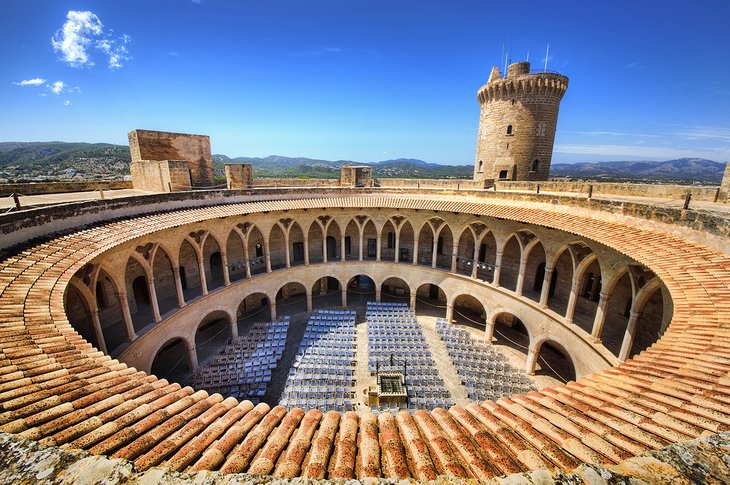
Bellver Castle sits on a hill just west of the port at Palma in Mallorca. It was built by King James of Majorca during the 14th century as both a residence and fortification, protecting the crown through several sieges until it fell in the 16th century. Today, it is a symbol of Palma.
This massive castle was constructed in a truly unique design, with the majority of the structure consisting of a circular building that is reminiscent of Rome's Colosseum. The interior courtyard is expansive, circled by two stories of arcaded patios. Four circular towers stand guard around the central castle, with the silhouette of the old moat carved around them.
Once host to court events, the central courtyard is now used as a concert venue and center for cultural events. Guided tours of the castle are available, and it houses an excellent historical museum.
- Read More: Tourist Attractions in Majorca (Mallorca)
Peñafiel Castle
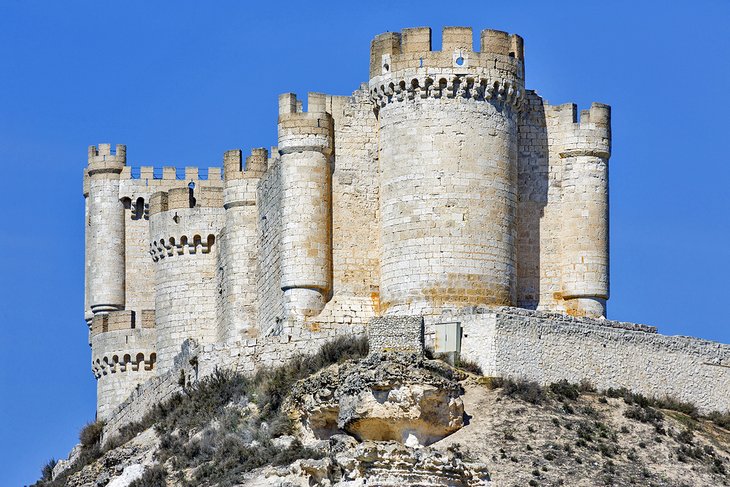
Located in the province of Valladolid, Peñafiel Castle is an imposing and beautiful sight atop a long ridge. When lit from below at night, the castle resembles a massive ship due to its unusual elongated shape. The fortress stretches to a length of 210 meters while only reaching 33 meters at its widest, making best use of the full height of the rocky ridge.
Construction on the castle began during the late 10th century, with most of the currently visible structure dating from the 15th century when it was expanded and re-designed. A museum now occupies one wing of the castle, and visitors can explore the other wing by guided tour. Peñafiel Castle is located a little over an hour south of Burgos.
Castille de La Mota (Castle of La Mota)
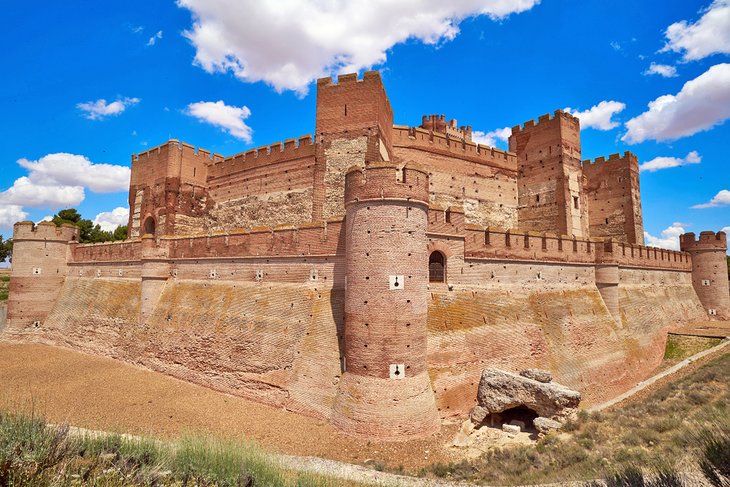
Perched on a man-made hill overlooking the town of Medina del Campo in Spain's Valladolid Province, the original structure was built during the 11th and 12th centuries using concrete with a brick façade. The holes left from the timber framing are often mistaken as scars from old battles despite their regular spacing. The castle underwent extensive renovations during the 15th century before falling under the rule of Ferdinand and Isabella.
The most imposing part of the castle is the Torre del Homenaje (Homage Tower), a 40-meter-tall rectangular tower that sits in the northeast corner of the inner section of the castle, topped by a crenelated keep and four smaller turrets. It is often referred to as the Great Tower of Castille. The castle can be visited in an easy day trip from Salamanca; advanced booking of castle tours is recommended.
- Read More: Attractions in Salamanca & Easy Day Trips
Alcazaba de Málaga (Citadel of Málaga)
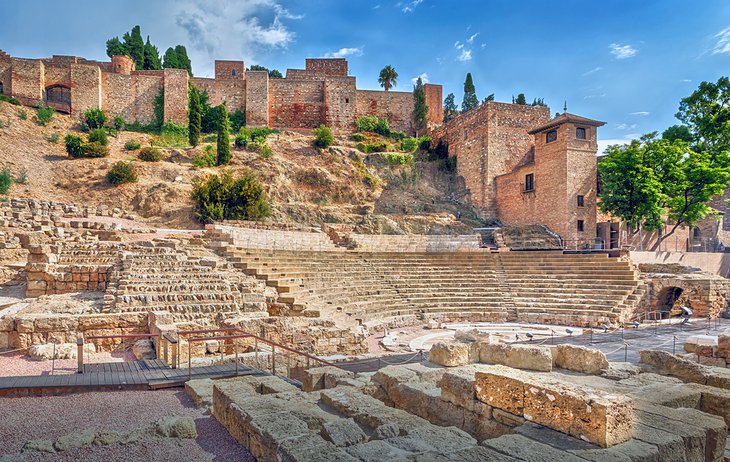
Situated on a hill overlooking the Mediterranean Sea on Spain's southern coast, the Citadel of Málaga and its immediate surroundings contain significant Roman, Arabic, and Renaissance sites. A first-century Roman theater sits at the base of the citadel on Gibralfaro Hill, and just above this is the original Arab defense, which was built in the 8th century. A passageway connects this to additional fortifications and residential areas that were added during the 11th century.
The defensive portion of the citadel is characterized by a series of formidable square turrets and battlements. The interior features several ornamental gates, patios designated for gardens, orchards, and the pool, three major towers, and the royal chambers, as well as the castle's dungeons. The citadel has been restored, and can be seen via guided tour.
- Read More: Tourist Attractions in Málaga
Castillo de Peñíscola (Peñíscola Castle)
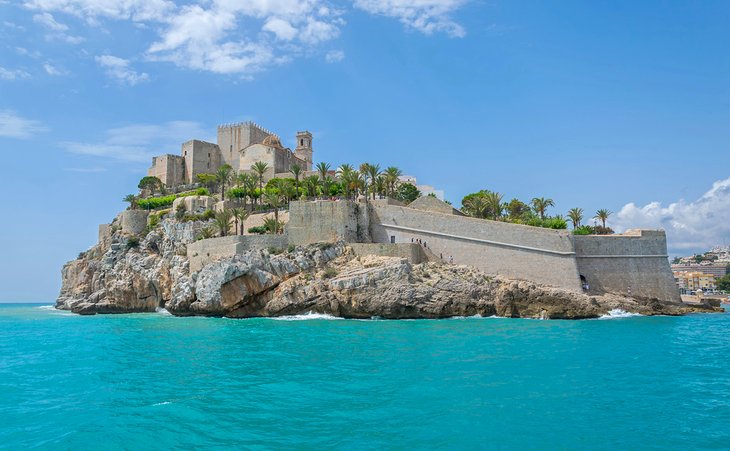
Located on the southeastern coast halfway between Valencia and Tarragona, Peñíscola Castle overlooks one of Spain's lovely beach towns from a height of 64 meters above sea level. It is known for being built by the mysterious Knights Templar during the 12th century, and features walls of carved stone and barrel-vaulted rooms. Perhaps because of this solid construction, very few changes have been made to the structure in the centuries since.
Today, large portions of the castle and grounds have been turned into a botanic park, full of native trees and flowers. This is a beautiful place to visit for the gardens, as well as the panoramic views of the Mediterranean from atop the vantage point.
New Castle of Manzanares el Real
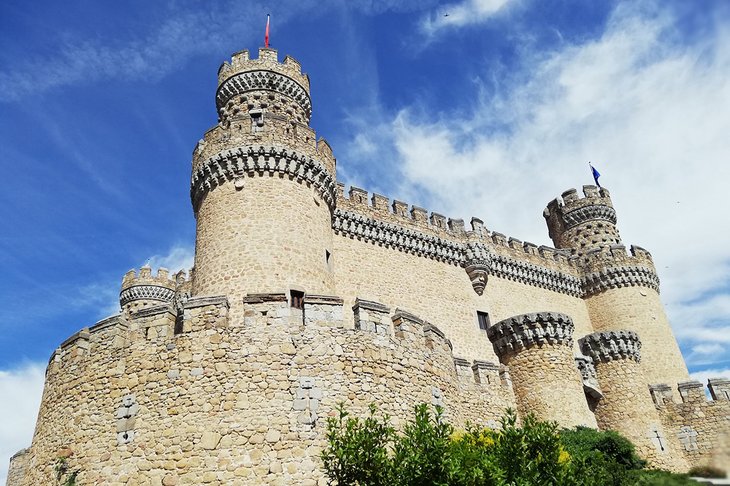
Also known as Castillo de los Mendoza (Mendoza Castle), named for the royal family who resided here, this castle is known for being used in the filming of El Cid, the epic 1961 movie. With its photo-worthy exterior, one can easily see why it was chosen - the stately, round crenelated towers are decorated with ornamental Gothic stonework, and multiple layers of walls and double-towers speak to its use as both a fortress and a palace.
Constructed entirely of granite, the castle features a main tower that is hexagonal in shape and four circular towers. Visitors can tour the palace, including all six floors; multiple galleries; and the towers, which provide excellent views of the surrounding countryside.
The castle is maintained by the Community of Madrid and houses an excellent museum dedicated to the history of Spanish castles. This medieval fortress is one of the most popular day trips from Madrid.
Castillo de Burgalimar (Burgalimar Castle)
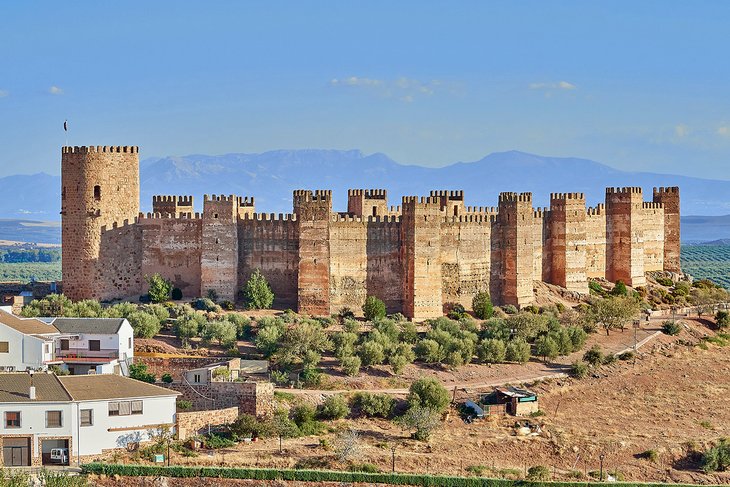
The Moorish Burgalimar Castle is also known as Castillo Baños de la Encina, named for the town it watches over. It's located in northern Andalusia. Built in 968 by the Moors, it was constructed using rammed earth that was clay-based. It was eventually taken over by Christian armies in 1225. Much of the original architecture remains, however structures were added in the following centuries.
Some of the most significant additions occurred during the 15th century, including the Christian Tower of Homage; one circular tower; and a Gothic keep, which was added to one of the original towers. As a fortification, this palace was among the strongest, with double walls and fifteen fortified towers. The site was deemed a National Historic Monument in 1931.
Lorca Castle (Fortress of the Sun)
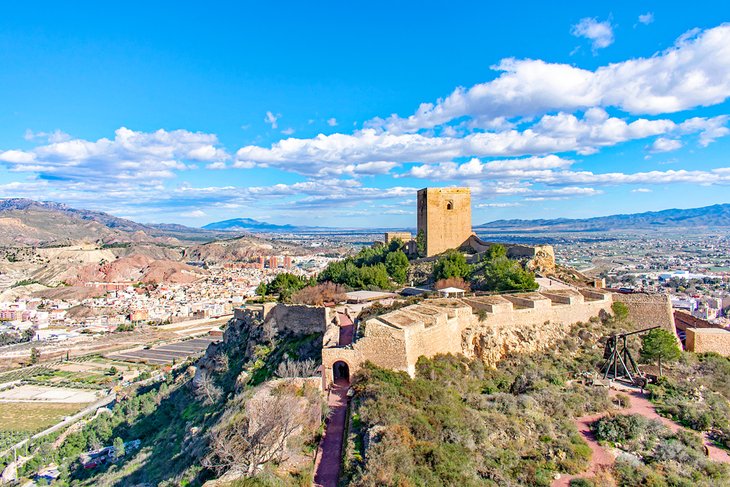
Located in Spain's Murcia region, this 13th-century castle overlooks the Guadalentín Valley, once a major fortification along the edge of the neighboring Granada region. It has been restored to allow visitors to safely explore, and there are several tours and interpretive programs available, as well as kids' workshops. The site is also home to exhibits containing archaeological finds from the surrounding area, including evidence that the site has been inhabited for well over three millennia.
Points of interest within the castle are its main towers, courtyard, and a unique Jewish Quarter with a synagogue. The Espolón Tower demonstrates Mudejar influence, while the Alfonsí Tower contains vaulted ceilings in Gothic style.
Visitors can treat themselves to a meal served right in the fortress courtyard featuring locally sourced produce from the Guadalentín Valley, including vegetarian and organic options. In the summer, guests can book a special supper here that includes music and a tour.
Address: Carretera del Castillo, 30800 Lorca, Murcia, Spain
Alcazaba of Almería
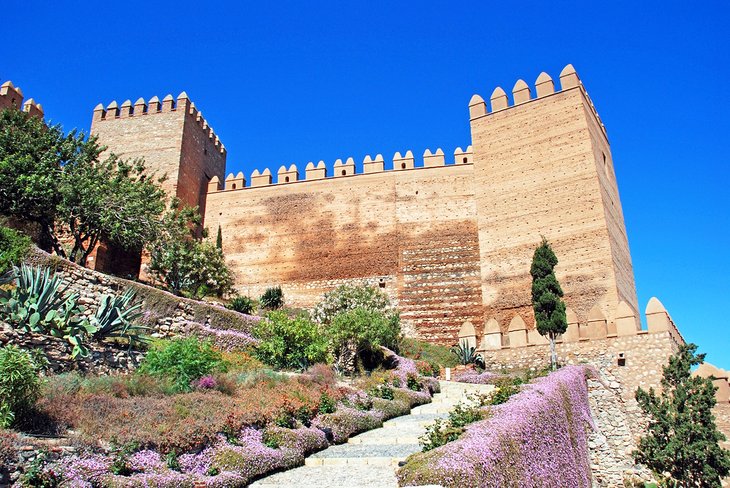
Construction of the Alcazaba of Almería was begun in the mid 10th century by the Arabic King Abderramán III, intended as not only a military fortress but also a residence and center of government. It was designed with a series of walled enclosures, the innermost intended as a residential area for civilians, including homes, baths, and a mosque.
Like many of Spain's castles, the Alcazaba of Almería was later added to and modified by Christian rulers in the middle ages, and the castle features many Gothic influences that reflect the changing styles. Among the castle's most remarkable features are the entrance at the Torre de la Guardia (Guard Tower); the Puerta de la Justicia (Justice Gate); and the Torre de los Espejos (Tower of Mirrors), which provides excellent views of the Bay of Almería.
Thanks to its classic look, this castle has had a supporting role in several major films, including the James Bond thriller Never Say Never Again, Indiana Jones and the Last Crusade, Wonder Woman 1984, and episodes of Game of Thrones.
Address: Carretera Almanzor, 04002 Almería, Spain
Castillo de Ponferrada (Ponferrada Castle)
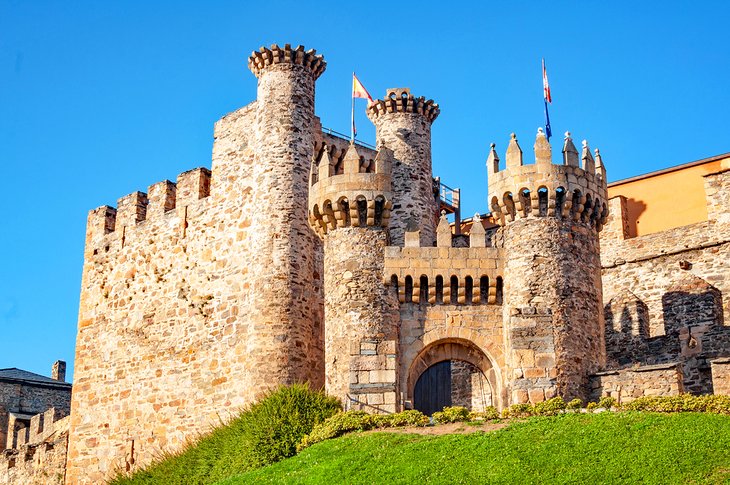
Also known as the Castillo de los Templarios (Castle of the Templars), this castle features round towers with ornate crenelation for a picture-perfect medieval fortress look. As the name suggests, the current structure was established in the late 13th century by the Knights Templar before their downfall. Most of the current visible structure was built between 1340 and 1440, when the first Count of Lemos took over the town of Ponferrada.
Beyond its stunning architecture, Ponferrada Castle is well known for its library collections of rare manuscripts and books. There is a room dedicated to religious codices and documents, which features a copy of the 9th-century Book of Kells, and another that focuses on the sciences and humanities, which includes illuminated texts once used by wealthy scholars, and early literary works.
Address: Gil y Carrasco, 1, 24401 Ponferrada, León, Spain
Official site: www.castillodelostemplarios.com



